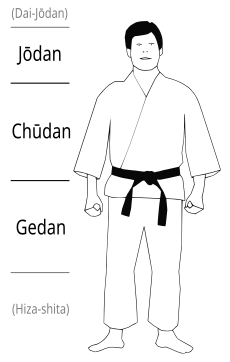Attack Levels
In Japanese martial arts ( Budō ) such as Aikidō or Karate and the Taekwondo derived therefrom, the attack level , sometimes also called the body zone, is understood to mean the areas of the human body where an attack technique hits, i.e. it has an effect. There are basically three levels of attack in the Japanese language: jōdan, chūdan, gedan . However, the terms jōdan, chūdan and gedan only describe the body area. When using weapons in Japanese martial arts (such as Iaidō , Kendō , Aikidō, etc.), the terms jōdan no kamae, chūdan no kamae and gedan no kamae are used to describe the position of the weapons in a basic position . In addition, there is also the term Dai-jōdan for the sword held high above the head in these martial arts .
In the case of attacks in martial arts practice, it is important to differentiate between the attack levels, as individual techniques such as punches (e.g. chūdan dsuki ) or kicks can be performed on different areas of the body. In karate training, for example, the students must pay close attention to which level of attack was announced out loud by the teacher in order to avoid injuries.
Attack Levels in Japanese Martial Arts
Jōdan
The Jōdan area is the upper level of attack and includes the neck and head. Accordingly, a straight punch ( Oi-zuki ) to the head area is called Oi-zuki jōdan . A semicircular kick ( Mawashi-geri ) to the head is called Mawashi-geri jōdan . The group of defense techniques outlined above is called Jōdan-uke . This includes, for example, Age-uke (upward defense with the forearm), Haishu-uke (back of the hand defense in the head area) or Morote-uke (upper block defense with a supporting second arm).
Chūdan
The Chūdan area is the middle level of attack and extends from the neck down to the waistline. A wrong punch ( Gyaku-zuki ) to the solar plexus ( Plexus solaris ) is therefore called Gyaku-zuki chūdan . A straight kick ( Mae-geri ) to the stomach is called Mae-geri chūdan . The group of defense techniques carried out in the middle is called Chūdan-uke . These include, for example, Uchi-ude-uke (defense drawn from the inside out with the forearm), Soto-ude-uke (defense drawn in from the outside with the forearm) and Shutō-uke (sword -hand defense ).
Thought
The Gedan area is the lower level of attack and extends from the belt down to the knees. The gedan level is largely a taboo zone in most styles, as it includes the genital area, among other things. This is why the number of attack techniques in the Gedan area is rather low. Arm techniques can only be used as defense techniques (Gedan-uke) , for example in Gedan-barai (arm defense in the Gedan area against foot attack Mae-geri ). Attacks are carried out specifically in self-defense, for example as Yoko-geri kekomi gedan ( Yoko-geri = lateral foot kick) to the thigh-knee area.
Further attack levels
A fourth level of attack , which is unsuitable for thrusting and punching techniques , is called Hiza shita and extends from the knees down to the floor. In this area, only foot sweeping techniques are usually performed, which aim to throw the opponent off balance.
literature
- Okazaki Teruyuki , Stricevic Milorad: Modernes Karate , Falken Verlag, 1987, ISBN 3-8068-4280-9
- Morihei Ueshiba : Budo. The textbook of the founder of Aikido. ISBN 3-921508-57-6
